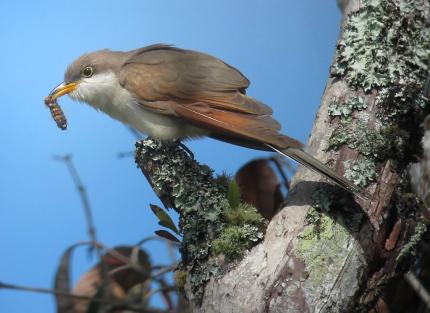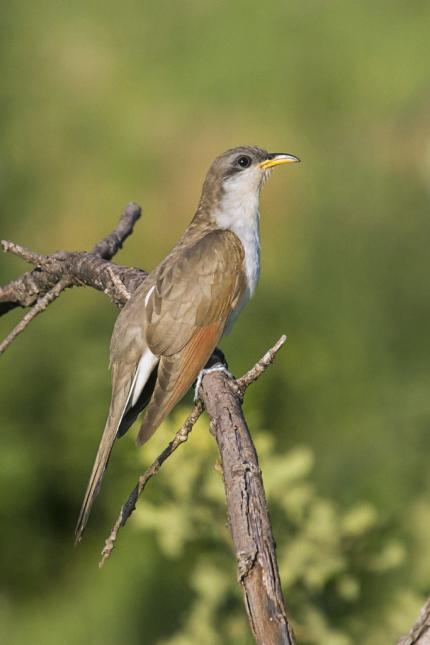Low-
Moderate
The yellow-billed cuckoo has been a very rare migrant and summer resident since about 1940, when it was last known to breed in Washington. Recovery efforts are probably best directed at remnant nesting habitats still occupied in the southwest United States.
Description and Range
Physical description
The yellow-billed cuckoo is about 12 inches in length. This bird is brownish above and white below. The beak is yellow, hence the species’ name. The underside of the tail feathers has a bold black and white pattern.
Ecology and life history
Yellow-billed cuckoos display a strong preference for large, continuous riparian zones with cottonwoods and willows. In Washington, nesting also took place in fir woodlands and open brushy hillsides.
A migratory species, yellow-billed cuckoos begin arriving in western North America in mid to late May. Most western birds arrive at their breeding range from early to mid-June and depart from late August to mid-September.
The yellow-billed cuckoo diet consists mainly of large insects such as caterpillars, grasshoppers, katydids, beetles, and crickets, with small vertebrate prey also taken.

Most nesting occurs between June and early August, but can extend from late May until late September. This species usually builds its own nests and cares for its own young. In the west, nests are often placed in willows, cottonwoods, and shrubs. Two clutches may be laid in years of good food supply. Females occasionally lay their eggs in the nests of other birds.
Geographic range
Yellow-billed cuckoos nest across much of the eastern and central United States and parts of Canada, Mexico, and the Caribbean, and overwinter in the northern three-quarters of South America. Breeding also once occurred over much of the western United States, but is now largely restricted to a few areas of the southwest after major population declines. The population size and breeding range of western yellow-billed cuckoos have greatly declined during the past century, with only 680 to 1,025 breeding pairs estimated to remain as of 2017.
The species formerly bred uncommonly in parts of western Washington, but is now a very rare migrant statewide, with single records in four years between 2000 and 2014. Breeding probably ended in the state by about 1940.
Just 20 sightings of yellow-billed cuckoos have been documented in Washington since the 1950s, with 19 occurring from 1974 to 2016 at an average rate of one sighting every 2.3 years. Sixteen of the 20 records occurred in eastern Washington. All or nearly all of the birds recorded since the 1950s were very likely non-breeding vagrants or migrants, indicating that cuckoos are now functionally extirpated in the state.
Nevertheless, due to a lack of surveys for the species and the presence of small areas of habitat in Washington, the possibility exists that this species may occasionally breed in the state and that these rare breeders are yet to be discovered.
For maps of range-wide distribution and conservation status of this species, check out NatureServe Explorer and the International Union for Conservation of Nature Redlist.
Climate vulnerability
Sensitivity to climate change
Low-
Moderate
In Washington, yellow-billed cuckoos are likely sensitive to climate change through impacts in the availability of food resources. Warming temperatures may decrease the availability of food resources such as lepidopterans and/or lead to earlier spring peaks in food abundance which yellow-billed cuckoos may miss.
Exposure to climate change
Moderate
- Increased temperatures
- Increased drought and/or changes in precipitation or temperature may affect the peak timing of insect emergence or the timing of yellow-billed cuckoo arrival from wintering grounds, resulting in reduced food availability and possible impacts to breeding success.
Conservation
Conservation Threats and Actions Needed
- Fish and wildlife habitat loss or degradation
- Threat: Loss and degradation of riparian forests are a broad problem across the west caused by dam construction, flood control practices, commercial and residential development, changes in farming and ranching practices, and nonnative plant invasions.
- Action: No management activities targeting this species are currently conducted due to its scarcity in Washington although broader efforts to protect and restore riparian forests would perhaps be beneficial.
- Resource information collection needs.
- Threat: Document records of yellow-billed cuckoo occurrence in Washington.
- Action: Continue working with the birdwatching community to continue documenting sightings of cuckoos in Washington.
See the Climate vulnerability section above for information about the threats posed by climate change to this species. In addition, agricultural pesticide use, which may affect prey abundance as well as the birds' health, is a potential additional threat.
Resources
References
Tweit, B. 2005. Yellow-billed cuckoo (Coccyzus americanus). Page 210 in T. R. Wahl, B. Tweit, and S. G. Mlodinow(eds.). Birds of Washington: status and distribution. Oregon State University Press, Corvallis, OR, USA. 436 pp.
USFWS. 2013. Endangered and threatened wildlife and plants; proposed threatened status for the western distinct population segment of the yellow-billed cuckoo (Coccyzus americanus). Federal Register 78:61622-61666
